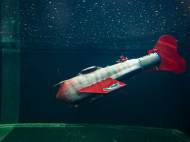Gliding Robot ACE – robotic fish that can both swim and glide
 There are many research groups around the world with a goal to develop robotic fish that could be used to monitor potential environmental problems before they become too large to handle. Back in 2009, a group of researchers from Michigan State University (MSU) came up with their prototype of robotic fish. Recently, they revealed a more versatile version with a new name – Gliding Robot ACE (or Grace).
There are many research groups around the world with a goal to develop robotic fish that could be used to monitor potential environmental problems before they become too large to handle. Back in 2009, a group of researchers from Michigan State University (MSU) came up with their prototype of robotic fish. Recently, they revealed a more versatile version with a new name – Gliding Robot ACE (or Grace).
Designed and built by Xiaobo Tan, MSU associate professor of electrical and computer engineering, and his team, Grace features a significant improvement which distinguish it from other robotic fish. As its name says, Grace has the ability to glide, and it can glide long distances under water.
In order to glide, Grace is equipped with a pump mechanism that pushes water in and out of its body. This enables the robot to sing or rise in the water by changing its buoyancy. Robotic fish’s battery pack is located on a rail-like system which goes from its back fins to its head, and it allows it to shift the weight to its back and front end, thus respectively directing robot’s nose up or down.
“Swimming requires constant flapping of the tail, which means the battery is constantly being discharged and typically wouldn’t last more than a few hours”, said Tan. “The disadvantage to gliding is that it is slower and less maneuverable. This is why we integrated both locomotion modes – gliding and swimming – in our robot. Such integration also allows the robot to adapt to different environments, from shallow streams to deep lakes, from calm ponds to rivers, with rapid currents.”
This ability enables it to gather valuable data that can aid in the cleaning of lakes and rivers, while gliding through the water practically indefinitely, using little to no energy. Battery power is used to run the pump and shift the battery pack, and researchers claim that it should be able to power about 200 dive cycles. According to Tan, Grace could travel about 124 miles (200 kilometers) if the water is 500 meters (1,600 feet) deep.
Underwater gliders (or seagliders) are becoming more common in oceanography. In fact, one traveled all the way across the Atlantic Ocean in late 2009. One major difference in Grace is that, aside from its swimming capability, it is about 10 times smaller and lighter compared to other current commercially available underwater gliders. Robotic fish developed by the MSU researchers is also equipped with an array of sensors that not only allow it to travel autonomously, but also measure water temperature, quality and other pertinent facts.
Late last year Tan and his team took Grace for a test drive on the Kalamazoo River, the site of a 2010 oil spill. Interestingly, the robot’s crude oil sensor had some readings upriver from where the spill occurred, as well as higher reading downstream from the spill site.
“She swam at three sites along the river and wirelessly sent back sensor readings”, said Tan. “I’m not sure, but we may have set a world record – demonstrating robotic fish-based sampling with commercial water-quality sensors in a real-world environment.”









Leave your response!